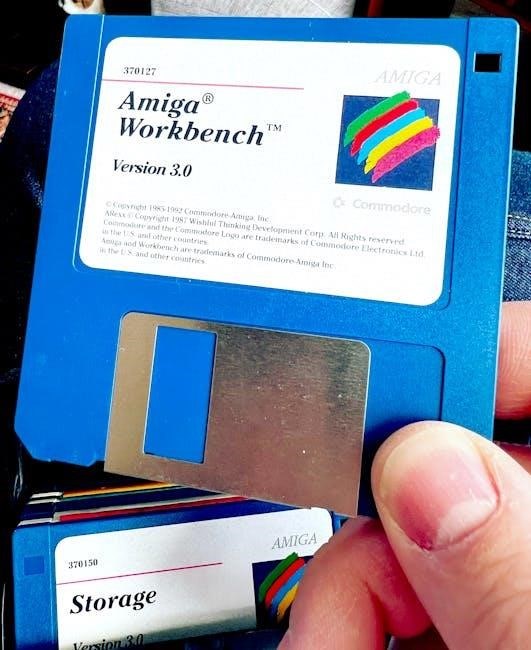
vfc 400 data logger manual
Welcome to the VFC 400 Data Logger manual. This guide provides essential information for operating and optimizing your device, ensuring accurate temperature monitoring and data recording.
1.1 Overview of the VFC 400 Data Logger
The VFC 400 Data Logger is a advanced temperature monitoring device designed for precise data collection and analysis. It features a stainless steel temperature probe, customizable alarm settings, and robust data storage capabilities. Suitable for various environments, the logger ensures accurate temperature documentation, making it ideal for industrial, medical, and storage applications. With user-friendly software and a durable design, the VFC 400 is a reliable solution for maintaining temperature records and ensuring compliance with regulatory standards.
1.2 Key Features and Benefits
The VFC 400 Data Logger offers a range of features, including a high-accuracy temperature probe, real-time data monitoring, and customizable alarm notifications. Its robust design ensures reliability in harsh environments. The device supports data export for further analysis and comes with user-friendly software for easy configuration. With low battery consumption and secure data storage, the VFC 400 is a versatile and efficient tool for temperature monitoring, ideal for industries requiring precise and consistent data collection.
Installation and Setup
Install the VFC 400 by plugging it into a USB port and following the software setup guide. Ensure all hardware components are securely connected before initializing the device.
2.1 Hardware Installation Steps
Begin by unpacking the VFC 400 data logger and its accessories. Connect the temperature probe to the designated port, ensuring a secure fit. Next, plug the docking station into your computer’s USB port. Power on the logger and wait for the initialization process to complete. Follow the on-screen prompts to install the LogTag Analyzer software. Once installed, verify all connections and proceed to configure the device settings as outlined in the manual. Proper installation ensures accurate data collection and reliable performance.
2.2 Software Setup and Configuration
Install the LogTag Analyzer software from the provided USB or download it from the official website. Launch the software and connect the VFC 400 logger to your computer using the docking station. The software will automatically detect the device. Configure settings such as sampling rate, temperature range, and alarm thresholds; Set the date and time to ensure accurate data logging. Finally, start the logging process and verify the status on the software interface. Proper software configuration is essential for reliable data collection.
2.3 Connecting the Temperature Probe
Connect the stainless steel temperature probe to the VFC 400 logger by aligning the probe connector with the logger’s port and gently pushing until it clicks. Ensure the probe is securely attached to avoid loose connections. Route the 5-foot cable carefully, avoiding sharp bends or twists. Once connected, the logger will automatically detect the probe. Use the LogTag Analyzer software to verify the connection and test the probe’s accuracy. Proper probe connection ensures reliable temperature data collection and accurate recordings.
Operating the VFC 400 Data Logger
Power on the logger, and the display will show the current status. Press and hold START to begin logging. The screen will confirm when recording starts. Proper probe connection ensures accurate data collection and reliable operation.
3.1 Starting and Stopping the Logger
To start the VFC 400 Data Logger, press and hold the START button until the screen displays STARTING and stops flashing (approximately 4-6 seconds). Release the button, and the logger will begin recording data. The screen will show RECORDING to confirm operation. To stop the logger, press and hold the START button again until the device confirms it has stopped. Ensure the logger is stopped before disconnecting or performing maintenance to avoid data loss or corruption.

3.2 Setting Up Temperature Alarm Notifications
To configure temperature alarms, plug the docking station into your PC and open the LogTag Analyzer software. Select the VFC 400 logger and navigate to the alarm settings. Set your desired high and low temperature limits using the software interface. Enable notifications by checking the alarm box. Save your settings and ensure the logger is restarted to apply changes. The device will now alert you when temperatures exceed the set range, ensuring timely responses to temperature fluctuations. Always test alarms post-configuration for functionality. Proper setup ensures reliable monitoring and alerts. Follow software instructions carefully to avoid errors. Use this feature to maintain optimal temperature conditions in your environment. Ensure all settings are saved before disconnecting. Verify alarm functionality by triggering a test notification. This ensures your system is ready for real-time monitoring. Adjust thresholds as needed based on your specific requirements. Regularly review and update alarm settings to maintain accuracy. Use the LogTag Analyzer to track alarm history for detailed insights. This feature enhances your ability to manage and respond to temperature changes effectively. Always refer to the manual for advanced customization options. Utilize alarm notifications to prevent temperature-related issues in your storage or monitoring environment. Ensure all personnel are trained on alarm responses. Customize notifications to suit your operational needs. This setup ensures you stay informed and proactive about temperature changes. Maintain accurate records of all alarm events for compliance and analysis purposes. Use the alarm feature to enhance your data logging experience and ensure optimal conditions are consistently met. This step-by-step guide helps you maximize the VFC 400’s capabilities for reliable temperature monitoring. Always follow the manufacturer’s instructions for best results. Use the software to fine-tune alarm settings for precision and reliability. Ensure all alarm configurations are tested and validated before deployment. This ensures seamless operation and accurate notifications. Refer to the manual for additional tips on optimizing alarm functionality. Use the VFC 400’s alarm system to streamline your temperature monitoring process and improve overall efficiency. Always keep the software updated for the latest features and improvements. Use the alarm setup to customize your monitoring experience according to your specific needs. This feature is essential for maintaining consistent and accurate temperature records. Ensure all alarm settings are properly configured to avoid false notifications. Use the LogTag Analyzer to review and adjust alarm thresholds as needed. This ensures your system remains responsive and accurate over time. Always prioritize alarm configuration for reliable temperature monitoring. Use the VFC 400’s alarm notifications to stay informed and in control of your environment. Follow the manual’s guidelines for optimal setup and performance. Use this feature to enhance your data logging experience and ensure compliance with regulatory standards. Always test alarm functionality after making changes. Use the software to generate reports on alarm events for detailed analysis. This feature is crucial for maintaining accurate and reliable temperature monitoring. Ensure all personnel understand how to respond to alarm notifications. Use the VFC 400’s alarm system to improve your operational efficiency and data integrity. Always refer to the manual for troubleshooting alarm-related issues. Use the LogTag Analyzer to customize alarm settings and ensure they meet your specific requirements. This feature is designed to provide you with real-time alerts for proactive management. Use the alarm setup to enhance your temperature monitoring strategy and maintain optimal conditions. Always follow the manufacturer’s recommendations for alarm configuration. Use the VFC 400’s alarm notifications to stay ahead of potential temperature-related issues. Ensure all alarm settings are reviewed and updated regularly. Use this feature to maximize the effectiveness of your data logging operations. Always ensure that alarm settings are configured correctly to avoid any monitoring gaps. Use the software to manage and adjust alarm thresholds for precise temperature control. This ensures your system operates smoothly and provides accurate notifications. Use the alarm feature to enhance your overall monitoring experience with the VFC 400. Always keep your software updated to access the latest alarm management features. Use the LogTag Analyzer to fine-tune your alarm settings and improve notification accuracy. This ensures you receive timely alerts for any temperature deviations. Use the VFC 400’s alarm system to maintain consistent and reliable temperature monitoring. Always test your alarm configuration before deploying the logger. Use the manual’s instructions to guide you through the setup process. This ensures your alarm notifications are set up correctly and function as intended. Use the alarm feature to enhance your data logging capabilities and ensure optimal temperature conditions. Always refer to the software help section for additional guidance on alarm setup. Use the VFC 400’s alarm notifications to streamline your monitoring process and improve efficiency. Ensure all alarm settings are properly configured to meet your monitoring needs. Use this feature to stay informed and proactive about temperature changes. Always follow the manufacturer’s guidelines for setting up and managing alarm notifications. Use the LogTag Analyzer to customize your alarm settings and ensure they are aligned with your operational requirements. This feature is essential for maintaining accurate and reliable temperature records. Use the VFC 400’s alarm system to improve your monitoring strategy and ensure compliance with standards. Always review and update alarm settings as needed to maintain optimal performance. Use the software to generate detailed reports on alarm events for further analysis. This ensures you have a comprehensive understanding of temperature fluctuations. Use the alarm feature to enhance your data logging experience and improve decision-making. Always ensure that alarm settings are configured correctly to avoid any monitoring issues. Use the manual’s instructions to guide you through the alarm setup process. This ensures your system is set up for reliable and accurate notifications. Use the VFC 400’s alarm notifications to stay informed and in control of your environment. Always prioritize alarm configuration for optimal monitoring performance. Use the LogTag Analyzer to fine-tune your alarm settings and improve notification accuracy; This ensures you receive timely alerts for any temperature deviations. Use the alarm feature to enhance your overall monitoring experience with the VFC 400. Always keep your software updated to access the latest alarm management features. Use the manual’s guidelines to configure alarm settings that meet your specific needs. This ensures your system operates smoothly and provides accurate notifications. Use the VFC 400’s alarm system to maintain consistent and reliable temperature monitoring. Always test your alarm configuration before deploying the logger. Use the software to manage and adjust alarm thresholds for precise temperature control. This ensures your system operates smoothly and provides accurate notifications. Use the alarm feature to enhance your data logging capabilities and ensure optimal temperature conditions. Always refer to the manual for troubleshooting alarm-related issues. Use the LogTag Analyzer to customize alarm settings and ensure they meet your specific requirements. This feature is designed to provide you with real-time alerts for proactive management. Use the alarm setup to enhance your temperature monitoring strategy and maintain optimal conditions. Always follow the manufacturer’s recommendations for alarm configuration. Use the VFC 400’s alarm notifications to stay ahead of potential temperature-related issues. Ensure all alarm settings are reviewed and updated regularly. Use this feature to maximize the effectiveness of your data logging operations. Always ensure that alarm settings are configured correctly to avoid any monitoring gaps. Use the software to manage and adjust alarm thresholds for precise temperature control. This ensures your system operates smoothly and provides accurate notifications. Use the alarm feature to enhance your overall monitoring experience with the VFC 400.
3.3 Accessing Historical Data
To access historical data, connect the VFC 400 logger to your PC using the provided docking station. Open the LogTag Analyzer software and select the logger from the device list. The software will automatically download and display the stored temperature records. Use the navigation tools to view data in chart or table format. Historical data can be filtered by date range for specific insights. Export data as CSV or PDF files for further analysis or reporting. Regularly backing up data ensures no information is lost. This feature allows you to review past temperature trends and maintain compliance with documentation requirements;
Data Analysis and Reporting
The VFC 400 logger allows users to analyze data via charts and tables, export records as CSV or PDF, and generate detailed reports for compliance and insights.
4.1 Understanding Data Logs and Charts

The VFC 400 generates detailed data logs and visual charts, enabling users to monitor temperature trends over time. Logs are timestamped and stored internally, while charts provide a graphical representation of data points. Users can zoom in/out and pan across charts for precise analysis. Each data point on the chart corresponds to a log entry, allowing for easy correlation. These tools are essential for identifying patterns, ensuring compliance, and troubleshooting temperature fluctuations. Regular review of logs and charts helps maintain accurate documentation and informed decision-making.
4.2 Generating Reports
The VFC 400 allows users to generate comprehensive reports from logged data. Using the LogTag Analyzer software, reports can be customized to include specific time frames, temperature ranges, and alarm events. Users can export reports in formats like PDF or CSV for easy sharing and compliance documentation. The software also enables the addition of notes or annotations, making reports more detailed and actionable. Regular report generation helps in maintaining accurate records and simplifies audits or presentations to stakeholders.
4.3 Exporting Data for Further Analysis

The VFC 400 allows seamless data export for further analysis. Using the LogTag Analyzer software, users can export data in formats like CSV or PDF. To export, connect the docking station to a PC via USB and launch the software. Select the desired data range and format, then export. This enables detailed analysis in tools like Excel, enhancing reporting and compliance needs.
Maintenance and Troubleshooting
Regular maintenance ensures optimal performance. Check temperature probes for damage, ensure firmware updates, and clear old data. Address common issues like sensor malfunctions or connectivity problems promptly.
5.1 Routine Maintenance Tasks

Performing routine maintenance is crucial for the VFC 400 Data Logger. Begin by inspecting the temperature probe for any signs of damage or corrosion. Clean the probe gently with a soft cloth to ensure accurate readings. Next, check the battery level and replace it if necessary. Regularly update the firmware to access the latest features and improvements. Additionally, clear old data logs to free up storage space and maintain optimal performance. Always power down the device before servicing and allow it to discharge for safety.

5.2 Common Issues and Solutions
Troubleshooting the VFC 400 Data Logger involves addressing common issues. If the alarm status remains active after temperature normalization, restart the device. For shifted day summaries, adjust the time settings in the software. If the docking station fails to connect, ensure proper USB port functionality and driver installation. In case of inaccurate readings, calibrate the temperature probe following the manual instructions. Always refer to the LogTag Analyzer for detailed diagnostic support and software updates to resolve persistent issues effectively.

Best Practices for Using the VFC 400
5.3 Updating Firmware
To ensure optimal performance, regularly update the VFC 400 firmware. Connect the logger to your PC using the docking station, then open the LogTag Analyzer software. Navigate to the “Firmware Update” section and follow the on-screen instructions. Ensure the device remains connected throughout the process. Once completed, restart the logger to apply the updates. Always use the latest firmware version available on the official LogTag website to maintain compatibility and enhance functionality.